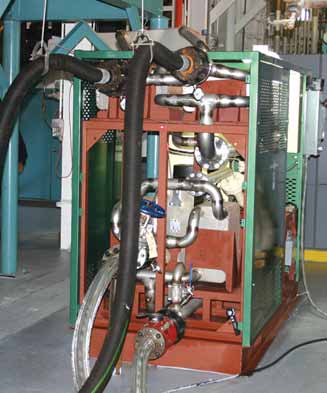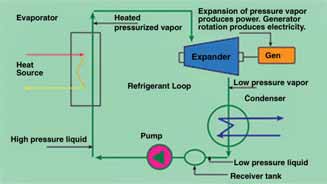
The Florida Canyon gold mine, located in central Nevada, is installing two “Green Machines”—integrated
heat recovery and power generation units—to produce electricity for mine use, employing 220°–230°F hot
water from its geothermal wells.
Nevada Mine Plans to Convert Geothermal Heat to High Voltage
Gold producer Florida Canyon will use heat recovered from its abundant supply
of geothermal hot water to generate electricity
By Russell A. Carter, Managing Editor

For example, in the search for practical alternative fuels and energy sources, mining company involvement spans the gamut of project size and costs from massive to miniscule. At the higher end are undertakings such as Vale S.A.’s announced consortium with palm oil producer Biopalma da Amazônia S.A. to manufacture biodiesel fuel starting in 2014. The venture, according to Vale, will be the biggest producer of palm oil in the Americas, and will invest a total of about $500 million in the project, with $305 million provided by Vale. A significant portion of the estimated annual production of 500,000 tons of palm oil will be processed into biodiesel fuel that will power a fleet of 216 locomotives in Vale’s North System rail network and equipment in the Carajás mines.
In Australia, BHP Billiton and Rio Tinto are among several major sponsors of a plan spearheaded by the engineering company WorleyParsons to develop the world’s biggest solar power station. The plant, for which a specific site has not yet been chosen, could cost as much as A$1 billion and would generate an initial output of 250 megawatts. Also in Australia, Newmont Mining in 2008 began a pre-feasibility study of solar thermal power technology which, it said could limit exposure of its Tanami gold mine in the Northern Territory to oil price volatility and reduce the operation's carbon footprint. The pre-feasibility study, which follows previous solar power investigations conducted from 2000–2006, is investigating a number of forms of concentrating solar thermal (CST) power including parabolic trough, power tower, Compact Linear Fresnel reflectors, and solar dish/engine. The study is also investigating the various thermal storage technologies that are being developed for CST technologies. Depending on the outcome of the investigation, Newmont said it might advance its efforts to a full feasibility study in 2009.
Lowering the Investment Level
Within a much lower range of financial
involvement are numerous mine site-level
projects aimed at exploring and developing
alternative energy sources to reduce the
impact of conventional-fuel/power price
fluctuations and supply—and perhaps even
save a few dollars in the process. For example,
a Nevada gold mine is currently in the
process of installing equipment to generate
electrical power from the mine’s abundant
supply of geothermally heated water.


ElectraTherm’s Green Machines are designed to capture waste heat from a variety of industrial or geothermal sources and convert it to emission-free electricity. Applying the organic Rankine cycle concept, the machines use a non-flammable, non-toxic and non-ozone-producing refrigerant selected for high performance at low temperature. The refrigerant—in this case, R245fa (pentafluoropropane)—circulates through an evaporator unit, where it is converted to vapor by the hot geothermal water. Under pressure, the vapor is forced through a twin-screw expander, turning it to spin an electric generator. The vapor is cooled to liquid form in the condenser, then pumped to higher pressure and returned to the evaporator to repeat the process. The Green Machines are rated to produce 50 kilowatts each at 480 volts, 50/60 Hz.
ElectraTherm says its technology is derived from six years of founder/internal development along with patents and licenses obtained from City University of London’s (CUL) Center for Positive Displacement Compressor Technology. At the core of ElectraTherm’s approach is the positive displacement, twin screw expander which uses an “N rotor profile” patented by CUL. ElectraTherm said it has signed an exclusive 20-year license agreement with CUL for this technology and supporting processes and software, and has filed for several additional patents.
Among the benefits of the N rotor
design, ElectraTherm notes that it allows
the expander to:
• Perform with less friction and greater
lobe strength than other twin screw rotor
profiles.
• Operate without need of expensive gear
boxes and/or electronics needed for highspeed
turbine operation.
• Enhance the cycle by admitting wet vapor
to the closed loop system—said to be
impossible with turbines—enabling
ElectraTherm’s patented process lubrication
system and eliminating any need for
the typical oil pump, tank, lines and filter.
• Operate in caustic environments that
would severely damage high-speed turbines
and turbo expanders.
According to ElectraTherm Engineer Andrew Oxner, the Green Machine will use about 200 gpm of the mine’s geothermal water, cooling it in the process and returning it to the mine’s water supply system. The first of the two machines was being installed in late September. “The installation only requires three connections,” said Oxner. “There’s a hot water loop that goes to the evaporator, a cold water loop that goes to the condenser, and an electrical connection that serves both is a power source for the unit’s electronics and as the outlet source for the power that it generates. It’s really a plug-and-play operation.”

ElectraTherm’s Vice-President of Sales, Rob Emrich, said the arrangement with Florida Canyon allows ElectraTherm to sell the power generated by the Green Machines to the mine at a discount to the local utility’s industrial power rate. Although the power generated by two machines will account for only about 0.5% to 1% of the mine’s overall demand, Emrich believes that there is a high likelihood that additional machines could be installed on site. Citing the seasonal variation of water flow and the amount of water needed to operate the mine’s heap leaching operation, Emrich surmised that two machines might be all the operation could support at certain times during the year, while at other times several machines could be operating.
Because of the many variables involved in the machine’s operation at Florida Canyon, Oxner was reluctant to offer an estimated payback period for the installation. As a general rule of thumb, however, he said payback on these types of installations in other industrial applications ranges anywhere from two to five years. “It should be noted that there are other benefits beyond the actual savings gained from the generated power,” said Oxner. “For example, a company installing the Green Machines can point to them as a commitment to improving energy usage and resource conservation, so there is a public relations value to them. We also have various financial incentives available that could improve the payback time.”
The Florida Canyon project is the first mine installation for ElectraTherm—and certainly not every mine has abundant supplies of geothermal water—but Oxner sees other opportunities within the industry, particularly at mines with stand-alone generating stations that produce a megawatt or more of power. By recovering waste heat from a large genset’s cooling jacket water, the company claims that as much as 10% of the genset’s rated output can potentially be recovered with a Green Machine. With installation of additional equipment to capture exhaust waste heat, this amount of power could possibly be recovered from gensets rated as low as 500 kilowatts.
Other possible markets for the company’s units include distributed generation power plants, coal-fired power plants, gas compressor stations, and industrialprocess waste heat sources.
Apart from the cost-saving prospects of generating power without using any additional fuel, there are other economic incentives driving interest in this technology, according to ElectraTherm. For example, in the U.S., President Barack Obama signed in February 2009 the American Recovery and Reinvestment Act (ARRA) into law, substantially increasing funding for existing and new energy programs and initiatives. ARRA contains over $37 billion in federal funding for energy efficiency, renewable energy and a host of other clean energy initiatives. These initiatives are also supported with about $20 billion in energy- related tax credits, as well as energy bonds and other favorable tax incentives.